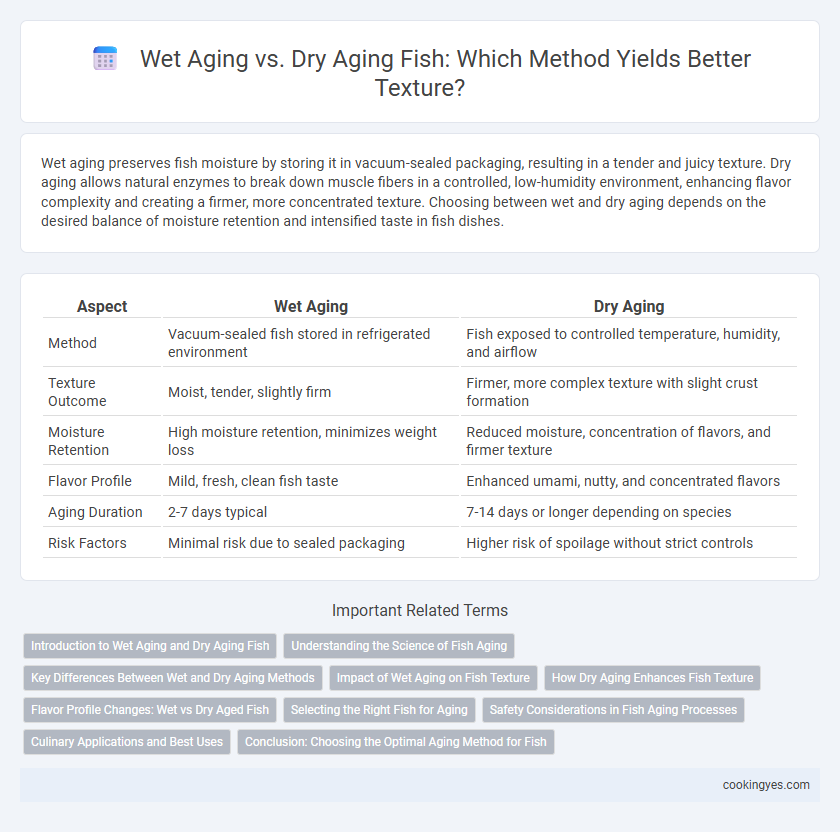Wet aging preserves fish moisture by storing it in vacuum-sealed packaging, resulting in a tender and juicy texture. Dry aging allows natural enzymes to break down muscle fibers in a controlled, low-humidity environment, enhancing flavor complexity and creating a firmer, more concentrated texture. Choosing between wet and dry aging depends on the desired balance of moisture retention and intensified taste in fish dishes.
Table of Comparison
| Aspect | Wet Aging | Dry Aging |
|---|---|---|
| Method | Vacuum-sealed fish stored in refrigerated environment | Fish exposed to controlled temperature, humidity, and airflow |
| Texture Outcome | Moist, tender, slightly firm | Firmer, more complex texture with slight crust formation |
| Moisture Retention | High moisture retention, minimizes weight loss | Reduced moisture, concentration of flavors, and firmer texture |
| Flavor Profile | Mild, fresh, clean fish taste | Enhanced umami, nutty, and concentrated flavors |
| Aging Duration | 2-7 days typical | 7-14 days or longer depending on species |
| Risk Factors | Minimal risk due to sealed packaging | Higher risk of spoilage without strict controls |
Introduction to Wet Aging and Dry Aging Fish
Wet aging fish involves sealing fillets in vacuum-packed bags to retain moisture and enhance natural enzymes that break down muscle fibers, resulting in a tender texture. Dry aging fish exposes the fillets to controlled air circulation and temperature, promoting moisture evaporation and concentrated flavors while altering the texture to a firmer consistency. Both methods influence the texture and taste profile of fish, with wet aging favoring softness and moisture retention, and dry aging enhancing flavor intensity and a denser meat structure.
Understanding the Science of Fish Aging
Wet aging fish involves vacuum-sealing fillets to retain moisture and promote enzymatic breakdown, resulting in a tender texture and enhanced flavor within a few days. Dry aging exposes fish to controlled air and temperature, enabling moisture evaporation and enzymatic activity that intensifies flavor and firms the texture over a longer period. Understanding proteolytic enzyme activity and water retention differences is crucial to optimizing fish texture through aging methods.
Key Differences Between Wet and Dry Aging Methods
Wet aging preserves fish texture by sealing the fillets in vacuum-packed bags, retaining moisture and enhancing tenderness through enzymatic breakdown without significant water loss. Dry aging exposes fish to controlled airflow and temperature, resulting in moisture evaporation that concentrates flavor and firms the texture but may reduce yield due to dehydration. The key differences lie in moisture retention, flavor intensity, texture firmness, and potential weight loss during the aging process.
Impact of Wet Aging on Fish Texture
Wet aging preserves fish texture by maintaining moisture content, resulting in a tender and juicy product. The controlled vacuum environment reduces oxidation and microbial growth, preventing texture deterioration. This method enhances enzymatic breakdown of muscle fibers, improving softness without compromising structural integrity.
How Dry Aging Enhances Fish Texture
Dry aging enhances fish texture by promoting moisture evaporation, which concentrates flavors and firms the flesh. The controlled environment allows natural enzymatic processes to break down muscle fibers, resulting in a tender, buttery consistency. Compared to wet aging, dry aging develops a more complex flavor profile and improved mouthfeel, making it a preferred technique for premium fish quality.
Flavor Profile Changes: Wet vs Dry Aged Fish
Dry aging fish intensifies its flavor by concentrating natural enzymes and moisture loss, creating a richer, more complex taste profile often described as nutty or buttery. Wet aging preserves the fish's original moisture, resulting in a milder, fresher flavor with a tender texture due to enzymatic breakdown in a vacuum-sealed environment. The choice between wet and dry aging depends on desired flavor depth and textural firmness, with dry aging favored for robust seafood dishes and wet aging preferred for delicate preparations.
Selecting the Right Fish for Aging
Selecting the right fish for aging involves choosing firm, fatty species like salmon or tuna that benefit most from both wet and dry aging methods. Wet aging, which involves vacuum-sealing fish to retain moisture, enhances tenderness while preserving delicate flavors, making it ideal for lean fish. Dry aging exposes fish to controlled air conditions, concentrating flavors and improving texture in fatty varieties, but requires precise temperature and humidity control to prevent spoilage.
Safety Considerations in Fish Aging Processes
Wet aging fish involves vacuum-sealing the product to prevent exposure to air, significantly reducing microbial contamination and spoilage risks compared to dry aging. Dry aging exposes fish to controlled air circulation, temperature, and humidity, requiring stringent monitoring to inhibit pathogenic bacteria growth and ensure safety. Proper hygiene, temperature control between 0degC and 4degC, and regular inspection are critical safety measures in both aging processes to maintain fish quality and prevent foodborne illnesses.
Culinary Applications and Best Uses
Wet aging preserves fish moisture by storing it in vacuum-sealed packaging, enhancing tenderness and maintaining a delicate texture ideal for sashimi and ceviche. Dry aging involves controlled exposure to air, intensifying flavor and firming the flesh, making it suitable for grilling or searing where a robust texture is desired. Both methods optimize fish texture for specific culinary applications, with wet aging favored for raw preparations and dry aging preferred for cooked dishes requiring concentrated taste and texture.
Conclusion: Choosing the Optimal Aging Method for Fish
Wet aging preserves fish moisture, resulting in a tender texture and mild flavor, making it ideal for delicate species like salmon and cod. Dry aging intensifies flavor and firms the flesh by allowing enzymatic breakdown and moisture evaporation, suitable for denser fish such as tuna and halibut. Selecting the optimal aging method depends on the desired texture profile and fish species, balancing hydration retention with flavor concentration.
Wet aging vs Dry aging for fish texture Infographic

 cookingyes.com
cookingyes.com